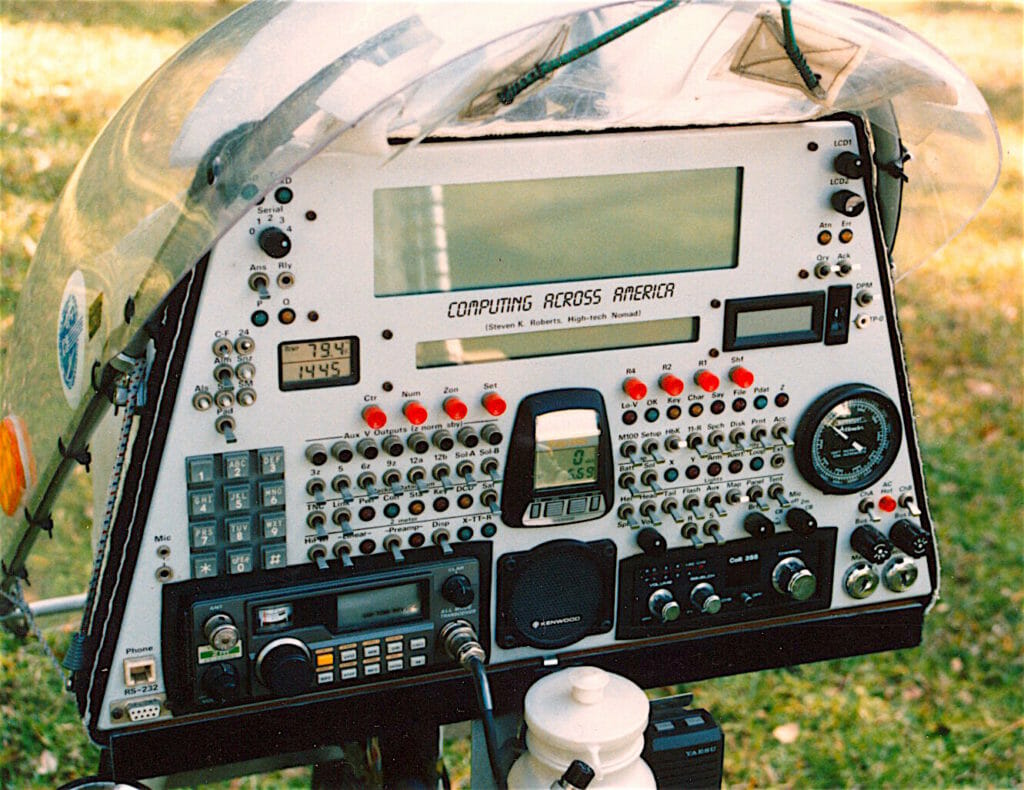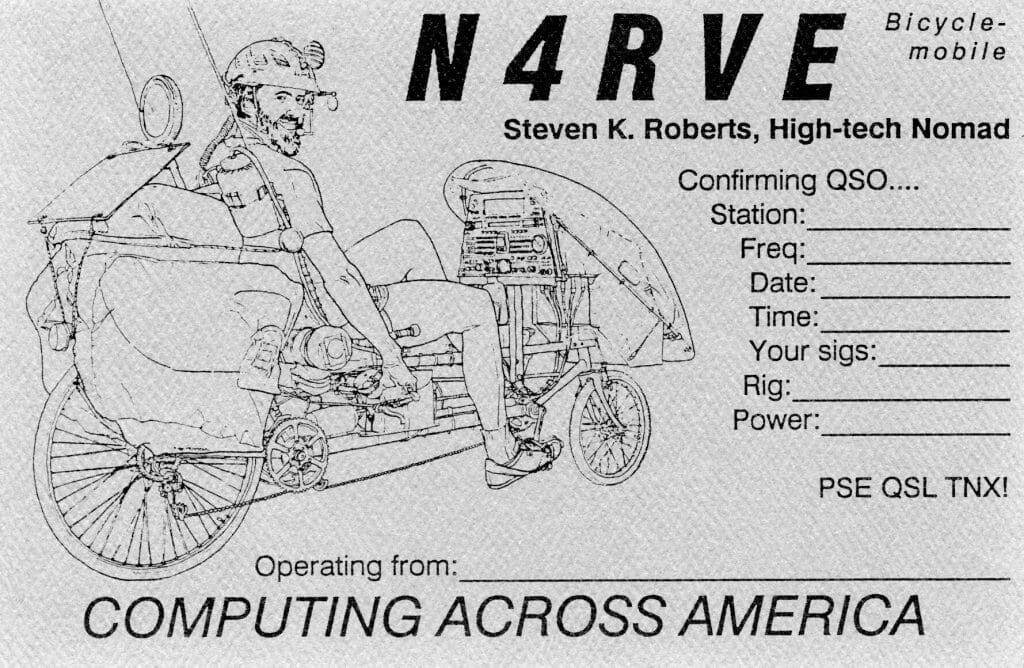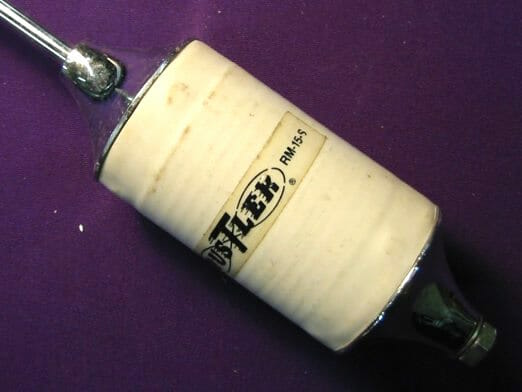
Life on a Megacycle
This article is about HF amateur radio on the Winnebiko II back in 1988, and is one of my favorites from the 73 Magazine series. It discusses the rig and antennas on the bike, of course, but also rhapsodizes about being a roving guest-op, cultural issues, expressiveness in CW, learning, techno-passions, and so on. This is from the epoch when I was in a groove… the bike systems were smooth, the travel brisk, and the words flowing.
My interest in HF has always been cyclic, so to speak; I’m not a contester or DXer, and in the Internet age it is no longer a novelty to communicate across the world. But radio is still magic, and this piece expresses that. The introductory article in the series is this cover story from February 1988.
by Steven K. Roberts, N4RVE
73 Magazine
November, 1988
If you have been following these tales of my high-tech nomadness for awhile, you’re getting a good image of the Winnebiko II — that 12-foot, 275-pound, 54-speed, solar-powered assemblage of gizmology that has become my electronic home. I’ve pedaled it 16,000 miles around the US, and am now hauling it to and fro in an old school bus, visiting hamfests and sponsors. Next spring, we’ll hit the road again with a team of fellow nomads.
An increasingly important part of this life is ham radio. Not just the obvious convenience of two meters, but “classic” ham radio as well — HF. In this, the 9th article of our series, I’d like to discuss some of the issues involved in running 3-30 MHz while living full-time on the road.

In last month’s article I explored the various motives that drive us hams to do what we do. Near the end I admitted to feeling about a dozen of the seventeen mentioned… many of them quite strongly, given the sweat involved in making ham radio a part of my nomadic lifestyle. 2 meters, of course, is at the appliance/survival level — it keeps me in touch with Maggie, local hams, and the reassuring presence of autopatch facilities when I feel the need for security.
But what about HF?
First of all, why go through the hassle? Why haul a 25-pound “radio pack” up mountains? Why spend hours erecting dipoles just for the pleasure of uttering plaintive QRP calls into the cacophony of the airwaves?
Is there survival value in stringing a wet noodle in Montana trees, plugging together a few cables, and hunkering over a battered Argonaut while Maggie conjures camp glopola? Perhaps, in an extreme case, we might need medical help in the wilderness someday. But that’s not what it’s about, nor is it the pure fun of making contacts, nor the twisted pleasure in coloring in counties on my US map whenever I work a new one. And were it only the technical satisfaction of making an unlikely lash-up work, the thrill would have faded by my tenth QTH.
A Global Home
No, the value of this goes to the very heart of my wanderings, touching the same cravings that, five years ago, led me to trade my security for freedom and hit the road. A traditional home wasn’t enough… I wanted a global one. And, of course, it’s now a question I hear almost every day: “What do you call home?” The answer has three parts…
On one level, home is the bike, the trailer, Maggie, and all the stuff we haul around with us. Home is also the whole world — a giant neighborhood that we prowl, visiting old friends and making new ones. But there’s a third level, every bit as important as the other two: Dataspace. That’s the vaporous global culture of electronically linked brains, made up of computer networks, BBS systems, the packet culture, and the planet-wide community of ham radio operators whose voices crackle through the bike’s headphones whenever I say something like “N4RVE, bicycle-mobile QRP. QRZ?” Thanks in part to this series in 73 Magazine, electronic doors open every time I go on the air and the security that comes from having an extended electronic family goes a long way toward delaying the urge to settle down.
But enough rhapsodizing. I get a lot of questions on the air about my bicycle-mobile HF rig, so here are a few details.
Pedaling The Megacycle
First of all, I should emphasize that this article comes at a time when the Winnebiko II is undergoing major surgery… and will appear in a few months as the new improved Winnebiko III. [note: I abandoned that name and called the new machine BEHEMOTH.] The HF system is evolving along with everything else, and I have to resist the temptation to tell you about all of the NEW stuff before it’s installed and working.
The heart of my present HF station is the Ten-Tec Argonaut 515 which, after a few months of flaky connectors, seems to work better and better the more it’s abused. I carry an external audio filter, also by Ten-Tec, as well as one of Bob Heil’s excellent headsets.
CW input is a function of whether or not I happen to be mobile. When in camp or visiting someone’s house, I use the MFJ “Pacesetter” keyer, built around a smooth Bencher paddle. This is heavy, of course, with a steel block to keep it in one place on the desk. I’m machining a light aluminum base that can Velcro to a plastic work surface or snap onto the door of the HF area in the new trailer.
For CW mobile, I’d use the handlebar keyboard and a piece of Morse-generation software output to the bike’s speech synthesizer, but then I’d never get to experience the magical rhythm of “Ben’s best bent wire,” or be able to participate in the shave and a haircut that terminates so many QSOs. There’s pleasure in both extremes — feeling the bits between your toes and watching layers of machine intelligence do the work for you. Perhaps the best of both worlds: Decode incoming CW with a computer, log it to RAMdisk, and then regenerate perfectly-timed code (complete with spelling correction) for the brain’s arcane pleasure. Hmm…
Anyway, the big issue that always arises in discussions of bicycle-mobile HF is the antenna. For a long time, I believed that mobile whips would be useless at QRP levels, especially with the dubious counterpoise of a bike (albeit a 275-pounder). I thus restricted my operation to campgrounds and backyards where I could uncoil my ropes and dipoles, terrorize neighbors with crescent wrenches slung over trees, and stay up beeping and squawking all night to get a return on my investment. It does work well… with Q-5 reports common, and frequent skepticism about my power levels. But I need to operate while pedaling.
Some time ago, I acquired an armload of Hustler mobile verticals, with super resonators and a folding mast. I gave it a try on 15 meters from somewhere in North Dakota (a QTH that added 10 dB to my 3 watt signal). Surprise… within a minute I had a three-way QSO going with Long Beach and New York. It works! I’ve started checking into the county-hunter’s net bicycle mobile.
Still, there’s pleasure in the dipole. I have flung it through a vent window in the peak of an Osceola barn, watched it flap wildly in Dakota winds, and tiptoed through southern gardens to untangle the rope. On the banks of the Yellowstone River, the wrench whistled past my ear and trashed a fender when I used a backing vehicle to get it unstuck from a 40-foot tree crotch. Something about a dipole in the trees seems to echo the spirit of ham radio, whatever that is, and every new QTH in my logbook has a header line that includes a sketch of antenna orientation and some comments about its mounting.
Speaking of the logbook, it is filling rapidly with the echoes of interesting contacts, many flagged with symbols indicating invitations or offers of assistance. Somehow, the essence of ham radio is clearer out here in the QRM and QRN — out here where contacts seem almost conspiratorial and surprises are frequent. In short, there’s magic at our fingertips! (Which reminds me: don’t forget to use the new CW exclamation mark, didahdahdidahdah, which is short for WOW. See my article in February’s 73 for more on this.) [note: this never caught on.]
Life As A Roving Guest-Op
One of the most interesting spinoffs of being a full-lime nomadic ham, of course, is the frequent experience of meeting other denizens of the airwaves. I’m getting to know all kinds of radios, for in every ham household there’s a room full of boxes to investigate.
I recommend that every ham try this: ask around on the air, swap a few invitations, and start spending a few hours a month at the helms of other peoples’ stations. The education is unbelievable. You’ll develop standards of comparison for competing rigs. You’ll quickly spot differences in performance that can be hard to quantify. And, of course, you’ll strengthen friendships, swap equipment and ideas, and learn more than ever about the hobby. Even though I’ve never had any kind of stable ham shack of any consequence, I frequently find myself in a consulting role — just because I’ve done time in so many others. I recently spent time with a good friend in Wisconsin whose HF rig didn’t “feel” right… it turned out he was running a vertical with no radials.
I’m writing this month’s column at the QTH of one of the big guns, K0PP in Deer Lodge County, Montana. Ken is an ARRL Section Manager, as well as the owner of the finest antenna farm I’ve ever seen (tribander, monobander, Zepp, 160 vertical, OSCAR, various VHF beams, and a forest of 75-foot towers). Driving all this is a TS-940 and a homebrew kilowatt. Ken’s a hot CW DXer who can blister along at 30-40 WPM.
But he tuned up the linear, aimed the antenna east, and turned me loose. “Uh, me? A kilowatt?” He grinned. Tentatively, I CQ’d. Instant response from the east coast. We chatted awhile, most of it comprised of my marveling at the rig and his marveling at a 40-over signal from Montana. Then, on a whim, I said QRZ after his final… and the roar of tangled voices was a sound I’d heard many times from the opposite perspective.
For four hours I sat in the hot seat, on a roll, buzzing with excitement. With the bike publicity, a killer signal, and a rare county in a rare state, I had a glimpse of how DX stations live. I started feeling guilty over rag-chews, knowing that a dozen or so squirming stations were muttering “come on, come on” with every languid comment. I started responding to two or three calls at a time: “New Mexico, go ahead; Tango Yankee, you’ll be next.” And I twinged a bit when a QRP station in Georgia got over his delight at Montana only to say, “Steve? That doesn’t sound like a solar-powered bicycle-mobile rig.” Used to being a whisper in the wilderness, I was suddenly the most powerful thing on 20 meters. Strange and wonderful… and a little frightening.
But the best part was watching another few pieces fall into the infinite puzzle — seeing not only a new aspect of the hobby, but also learning about great circle bearings, radiation off the sides of tribanders, the nature of passband tuning, the subjective difference between 100 and 1000 watts, the etiquette of big-gundom, the use of a rotor brake, and countless other little things too small to enumerate but, in aggregate, a major education. And that’s what it’s all about, and why I recommend that you make a point of learning at a furious pace instead of falling into the tired habits that can make any hobby, along with its practitioner, seem old.
I sometimes forget that learning is the essence of this journey, for it is not so much passion as necessity. Without the stimulus of change and new people, I’d never have found the motivation to so actively pursue new information. Try this: Open doors with HF, pass through them, and explore whatever you find. Make the bandwidth of your participation in this hobby as wide as possible. Visit other stations, and get to know both rig and operator. Push past the same old skeds and contests, for the more interesting we become as a culture, the more we will attract interesting people. There’s a critical mass somewhere, and it’s becoming increasingly clear that it’s not going to be reached through traditional public education.
But we of the networks and airwaves are in a unique position to find it, for we are dispersed across the planet, yet we communicate freely. Think of it as an intellectual responsibility to our species, as well as a whole new level of electronic fun.
Yep, bicycle-mobile HF sure is inspiring. See you somewhere on the air, on the road, or in the vapors of Dataspace!







You must be logged in to post a comment.